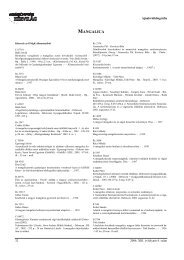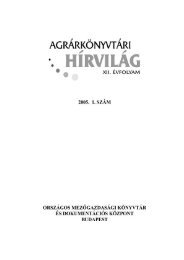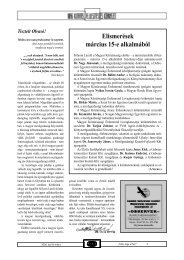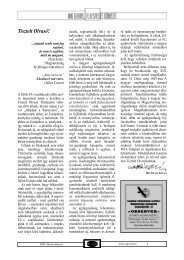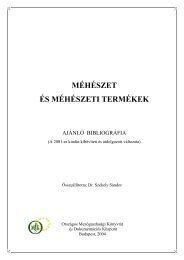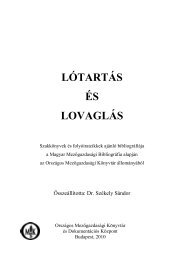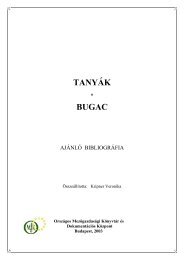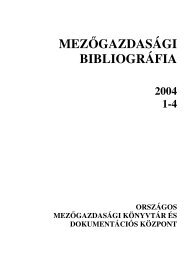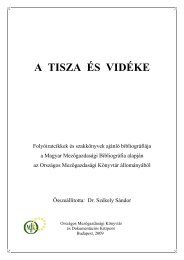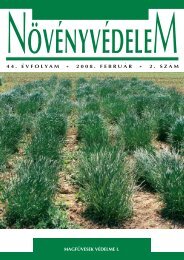hUNGARiAN AGRicUltURAl RESEARch
hUNGARiAN AGRicUltURAl RESEARch
hUNGARiAN AGRicUltURAl RESEARch
Create successful ePaper yourself
Turn your PDF publications into a flip-book with our unique Google optimized e-Paper software.
Gutermuth, Á., Pedryc, A. 1<br />
The possible source of resistance against blossom<br />
blight (Monilia laxa Ehr.) in apricot<br />
Blossom blight caused by Monilia<br />
laxa (Ehr.) is the most important<br />
fungal disease in Hungarian<br />
apricot orchards. The cultivars<br />
traditionally grown in the country<br />
are susceptible to Monilia laxa<br />
(Ehr.) at various rates. Totally<br />
resistant cultivars are not known.<br />
Chemical treatments against<br />
blossom blight during the<br />
flowering time are expensive,<br />
increase chemical pollution and<br />
often are not sufficient in defeating<br />
infection. In 2004 for example in<br />
the flatland area 3, while in the<br />
hilly region in Gönc 2 fungicide<br />
applications were necessary for<br />
decreasing the damages caused by<br />
disease however it did not provide<br />
full prevention(Drén et al. 2007).<br />
The reason of the inefficiency<br />
might be the latent infection and<br />
fungicide resistance. There are two<br />
different forms of the infection of<br />
apricot twigs by Monilia laxa. The<br />
well known and often described<br />
twig infection usually occurs<br />
during the rainy period and starts<br />
from the fungi penetrated flowers.<br />
In case of the second form the<br />
pathogen infected tissues of the<br />
twigs are assumed to be the source<br />
of the spreading of disease. This<br />
phenomena was described in sour<br />
cherry (Guido and Thomas, 2006)<br />
and observed in apricot orchards<br />
as well. These “latent” or “early”<br />
twig blight symptoms are already<br />
detectable at the time of full<br />
blossoming even under dry<br />
weather conditions. The core of<br />
the problem is that the fungicide<br />
treatments are recommended and<br />
useful just to control the flowers’<br />
infection.<br />
Development of the disease<br />
resistant cultivar would be the<br />
most effective and safety solution<br />
for the plant protection both for the<br />
environmental and economic<br />
reasons.<br />
Importance of that the above<br />
was emphasised even in the first<br />
apricot breeding program in<br />
Hungary launched by Gyula<br />
Magyar in the 1930’s. The main<br />
aim of his breeding activity was to<br />
increase resistance to frost and<br />
blossom blight (Pedryc, 2003,<br />
Pedryc, 1992). Among cultivars at<br />
present the choice the conventional<br />
Hungarian cultivars like<br />
‘Gönci magyarkajszi’ have a<br />
limited tolerance to the fungal<br />
infection but the majority of<br />
foreign cultivars is more susceptible<br />
to blossom blight than the<br />
locally selected cultivars.<br />
Unfortunately the field resistant<br />
cultivars are not commercially<br />
accepted because of the inadequate<br />
quality of fruit in contrast to many<br />
moderately resistant or susceptible<br />
cultivars which satisfy requirements<br />
of the modern market.<br />
In the experimental orchards of<br />
the Department of Genetics and<br />
Plant Breeding during the last 5<br />
years there were carried out<br />
consistent evaluation of twig<br />
infection on trees representing<br />
apricot cultivars from different<br />
geographical regions. Monitoring<br />
studies revealed that the single<br />
year of evaluation of the naturally<br />
infected trees and determination of<br />
the resistance level does not<br />
provide reliable results. Response<br />
to infection even in case of the<br />
same cultivar under variable, year<br />
depending weather conditions<br />
could be different. Further<br />
difficulties derived from uncertainty<br />
during ranking degree of the<br />
natural infection which is strongly<br />
influenced by the level of twig and<br />
fruit contamination occurred in the<br />
previous years. It is important to<br />
note that there is no significant<br />
correlation between the number of<br />
the primarily infected flowers and<br />
the amount of twigs damaged by<br />
disease. The latent infected twigs<br />
are the centres of the flower buds<br />
infection even before the<br />
blossoming time. The long term<br />
(five years) monitoring can<br />
decrease the influence of the<br />
yearly changing weather conditions<br />
and allows qualifying<br />
cultivars on the base of genetically<br />
determined differences.<br />
Screening of the resistance<br />
level of the cultivar assortment in<br />
the collection of department was<br />
carried out by the scoring of<br />
symptoms into the following<br />
groups:<br />
0 Totally resistant: flowers are<br />
destroyed but the mycelium<br />
cannot spread through the stem<br />
to the phloem of the twig, the<br />
pathogen did not destruct the<br />
branches.<br />
1 Tolerant: flowers are destroyed<br />
and the phloem of the shoots is<br />
injured. The spot of damaged<br />
tissue is smaller than 10 mm<br />
1Department of Genetics and Plant Breeding, Corvinus University of Budapest, Budapest<br />
Hungarian Agricultural Research 2009/3–4 17



